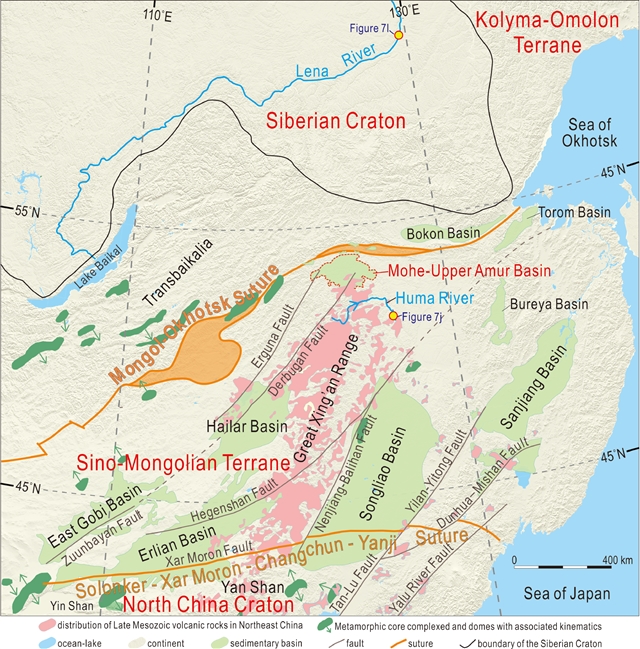
近日,中国科学技术大学杨永太团队研究了漠河-上阿穆尔盆地侏罗纪—早白垩世早期沉积与物源演化:对蒙古-鄂霍茨克洋东段闭合的制约。该项研究成果发表在2025年10月20日出版的《中国科学:地球科学》杂志上。
漠河-上阿穆尔盆地位于蒙古-鄂霍茨克缝合带东段南缘,其内充填的侏罗系—白垩系沉积地层对于揭示蒙古-鄂霍茨克洋最终闭合时限及晚中生代东北亚构造演化至关重要。然而,目前关于该盆地地层划分方案与物源演化模式仍存在争议。
基于盆地沉积充填序列分析与最新年代学数据,研究组重新建立了中国漠河地区与俄罗斯上阿穆尔地区的地层对比框架:漠河盆地的绣峰组—漠河组与上阿穆尔盆地的乌斯曼卡组—托尔布济诺组构成中侏罗世晚期—晚侏罗世早期的异期异相沉积,而漠河盆地的开库康组与上阿穆尔盆地的佩雷姆基诺组属早白垩世最早期形成的同期同义地层单元。碎屑锆石U-Pb年龄谱揭示,在开库康组沉积之前的侏罗纪时期,漠河-上阿穆尔盆地为单一物源体系,沉积物来自盆地以南区域;至早白垩世最早期开库康组沉积时,盆地构造格局发生重大转变,沉积范围快速萎缩,并形成南北双物源体系。
结合区域构造演化资料,研究组提出漠河-上阿穆尔盆地在晚侏罗世最晚期—早白垩世最早期记录的挤压构造体制与物源转变可能反映了蒙古-鄂霍茨克洋的最终闭合;而中侏罗世晚期—晚侏罗世早期与白垩纪两期裂陷作用,可能受控于亚洲大陆南缘陆-陆碰撞引发的远场构造效应——该碰撞事件触发了中国东北地区的构造逃逸,并主导了晚中生代东北亚的构造演化。
附:英文原文
Title: Jurassic-early Early Cretaceous sedimentary and provenance evolution of the Mohe-Upper Amur Basin: Constraints on the closure of the eastern Mongol-Okhotsk Ocean
Author: Zhixin GUO, Yongtai YANG
Issue&Volume: 2025/10/20
Abstract: The Mohe-Upper Amur Basin is situated adjacent to the southern margin of the eastern Mongol-Okhotsk Suture, and its Jurassic-Cretaceous sedimentary infill is crucial for revealing the final closure timing of the Mongol-Okhotsk Ocean and the tectonic evolution of Northeast Asia during the Late Mesozoic. However, there are still ongoing debates regarding the stratigraphic division and provenance evolution of this basin. Based on an analysis of the basin’s sedimentary successions and up-to-date geochronological data, this study reestablishes a stratigraphic correlation framework between the Mohe part in China and the Upper Amur part in Russia of the basin. The Xiufeng-Mohe formations in the Mohe Basin and the Usmanka-Tolbuzino formations in the Upper Amur Basin represent coeval heteropic successions deposited during the late Middle-early Late Jurassic, while the Kaikukang Formation in the Mohe Basin and Peremykino Formation in the Upper Amur Basin are contemporaneous synonymous stratigraphic units formed during the earliest Early Cretaceous. Detrital zircon U-Pb age spectra reveal that during the Jurassic, prior to the deposition of the Kaikukang Formation, the Mohe-Upper Amur Basin was fed by a single provenance, with sediments derived from the regions to the south of the basin. However, in the earliest Early Cretaceous, during the deposition of the Kaikukang Formation, the tectonic framework of the basin underwent a significant transformation, with a rapid shrinkage in sedimentary extent and the formation of a north-south dual provenance system. Integrating regional tectonic evolutionary data, this study proposes that the compressional tectonic regime and provenance shift recorded in the Mohe-Upper Amur Basin during the late Late Jurassic-earliest Early Cretaceous likely reflect the final closure of the Mongol-Okhotsk Ocean. The two phases of rifting during the late Middle-early Late Jurassic and during the Early Cretaceous may have been controlled by the far-field tectonic effects of a continent-continent collision along the southern margin of the Asian continent, which triggered tectonic escape of Northeast China and dominated the tectonic evolution in Northeast Asia during the Late Mesozoic.
DOI: 10.1007/s11430-025-1701-9
Source: https://www.sciengine.com/SCES/doi/10.1007/s11430-025-1701-9
Science China Earth Sciences:《中国科学:地球科学》,创刊于1952年。隶属于施普林格·自然出版集团,最新IF:5.7
官方网址:https://www.sciengine.com/SCES/home
投稿链接:https://mc03.manuscriptcentral.com/sces
